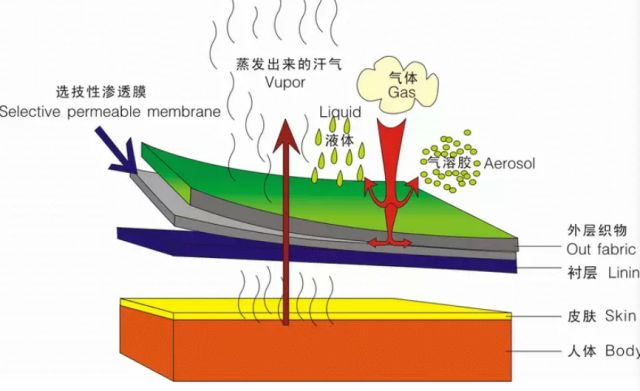TPE film characteristics and applications! “Breathable” film!
TPE can be extruded to form a self-supporting film for lamination of clothing fabrics. TPE film can protect and ensure the circulation of gas. This indicator can be measured by air permeability. Usually, the commercial method used to develop waterproof and moisture-permeable films is in the form of micropores, such as expanded stretched PTFE films, various polyolefin films, and wet-process polyurethane. In fabric applications, TPE nonporous films have application advantages, such as wear resistance and physical properties. When the film is laminated to the fabric, small molecules such as water vapor can pass through the film through dissolution/diffusion. “Breathable” polymers refer to materials that have a high permeability to water vapor, rather than materials that are permeable to air components such as oxygen and carbon dioxide. Generally speaking, the higher the active ingredients in the polymer, the The transmittance is higher.
The transmission behavior of water vapor molecules in dense films is generally carried out by molecular diffusion (refer to the absorption-diffusion model), using the vapor pressure difference on both sides to generate driving force. In order to reduce the transmission resistance, the film should have high permeability and low thickness. However, considering the physical properties of the film, the lower the film thickness, the better.
Microweather dynamics

Micro-weather is between the skin and the film The important parameters are temperature and humidity. To maintain a stable thermodynamic balance between body temperature and the environment (as the definition of comfort). The heat generated by human activities should be the heat dissipated to the environment. The main principle of heat loss, especially during physical activity, is the evaporation of water and the transport of steam to the environment.
During physical activity, the human body evaporates 800 grams of water per hour, and the corresponding heat loss is 1800KJ, which is about 80% of the heat generated.
TPE Chemistry

There are many factors that affect the permeability and Respiratory performance. For example, the intrinsic hydrophilicity of the material, crystallinity, and filler content can all affect the vapor transmission of the polymer. TPE is a vicious multi-segment copolymer of AB structure that is often used in medical materials. Elastomer materials with amide, urethane, and ester based hard segments often provide usable mechanical properties that make them useful in making films. By manipulating the backbone of the TPE molecule to improve permeability, for example – by integrating hydrophilic components to improve the polymer’s affinity for water.
In segmented TPE materials, penetration occurs mainly in the rubbery, elastic soft segment phase rather than through the hard segment phase. Therefore, the permeability properties show an inverse response to changes in hard segment content. Generally, the soft segment content mainly determines the water vapor permeability.
Soft segment
The basic polyether soft segment used in TPE films is mainly PEO and PEG or PPO/PEO copolymer, but PTMG is also used. Complete PPO segments are basically not used in breathable TPEs. Usually a mixture of different soft segments is used to balance the physical properties: for example, PEO is more hydrophilic, while PTMG has excellent mechanical properties and does not swell as much as the former. Increasing the CH2/O2 ratio reduces the compatibility of the soft and hard segments.
The molecular weight of the hydrophilic segment is within the same order of magnitude as other polyether-based TPEs, namely (600–4000g/mol).
PEO-synthesized TPE has the highest air permeability, close to well-known hydrophilic materials such as cellulose and polyvinyl alcohol. One disadvantage of using PEO is that the membrane surface is too sticky. According to the absorption-diffusion model, vapor permeability is a function of the amount of permeate and the speed of diffusion movement. High segmental motion, confirmed by the glassy temperature of all PEO soft segments, is 0°C, which allows for high diffusion coefficients. It is generally believed that high moisture vapor transmission rates are related to continuous soft segment phases. Water absorption is highly related to the content of soft segment PEO and is also related to the molecular weight of the soft segment. Increasing the molecular weight of the soft segment simultaneously increases the water absorption rate, which is believed to be related to the degree of separation of the soft segment and the hard segment. Low molecular weight soft segments usually result in films with strong physical properties. The high molecular weight soft segments form more obvious PEO microdomains, but the hard segments are weakened and can absorb a large amount of water. The increase in water uptake usually shows an exponential increase, which can be explained by physical cross-linking. These cross-links give the hydrophilic domains a swelling limit. When the PEO content is low, the absorbed water is bound to the PEO chain segments; above a certain PEO content, free water increases.
Hard segment
The melting point of the breathable TPE film is mainly determined by the type of hard segment. The high melt temperature is expected to be used in high temperature processes to provide thermal stability, such as lamination, waterproof fabrics, and lamination films. PA12 has 12 carbons in its repeating unit, giving most TPU hard segments a melting point of 175°C or below, while some polyester-based TPEs have melting points as high as 200°C. A series of important physical properties such as tensile strength and wear resistance are also mainly determined by hard segments. For example, films that combine nitrogen-containing PA12 and TPU hard segments are usually stronger.
Film Manufacturing
The most common techniques currently used to make breathable films are solution casting and melt extrusion. The thermoplastic nature of TPE films allows them to be solution cast using appropriate solvents. While TPU often uses MEK or other solutions, finding suitable solvents for PEBA and PEE is still a problem. Hydrophilic typeTPU, for example, may be cast from a viscous solution. After evaporation of the solvent, a dense film is obtained. By controlling phase separation, solutions can also be deposited into solvent-free porous membranes. Solution processes are generally more expensive than extrusion processes.
Melt extrusion is the best film-forming process. With the exception of extremely soft grades, most hydrophilic TPEs are suitable for extrusion. Drying of TPE materials is critical, as the material tends to absorb ambient moisture, and higher moisture levels can result in uneven film surfaces. The film can be formed directly from the melt through a die or blown through a round die. The amount and speed of melt passing through the die determine the final thickness of the film. TPE must exhibit sufficient melt strength to maintain traction. Crystallization may occur after the drawing is completed to reduce uneven drawing orientation and physical properties.
Blown film is the lowest cost and most effective method. Due to the nature of TPE itself, special equipment is required. Slip or anti-stick agents are often added to the bulk resin to facilitate processing, especially to benefit thinner films. Additives sometimes have a negative impact on breathability because they act on the most important moisture-absorbing interface on the membrane surface. Blowing film molding usually has advantages over films obtained by extrusion molding, as it can better control the breathability. Sometimes, blending several TPE materials together can tailor the properties of the film to meet the needs of a specific application.
The 4th Global Elastomer Summit
Daily topics arranged by UTPE for everyone: big trends, big directions, big applications!
The evening session is divided into four sub-venues: raw materials, granulation, auxiliaries, and equipment. Each venue will arrange detailed topics according to classification. Each venue is estimated to have 3-4 professional topics + a large number of Technical exchange + problem solving + promotion sharing.






